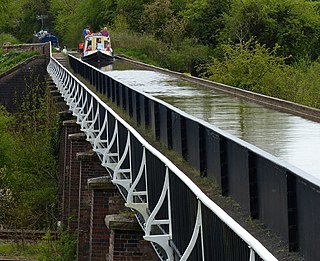
The Stratford-upon-Avon Canal is a canal in the south Midlands of England. The canal, which was built between 1793 and 1816, runs for 25.5 miles (41.0 km) in total, and consists of two sections. The dividing line is at Kingswood Junction, which gives access to the Grand Union Canal. Following acquisition by a railway company in 1856, it gradually declined, the southern section being un-navigable by 1945, and the northern section little better.

The Pontcysyllte Aqueduct is a navigable aqueduct that carries the Llangollen Canal across the River Dee in the Vale of Llangollen in northeast Wales.
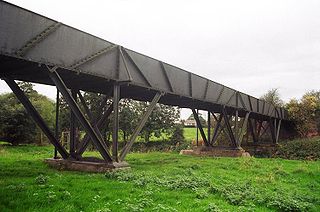
The Shrewsbury Canal was a canal in Shropshire, England. Authorised in 1793, the main line from Trench to Shrewsbury was fully open by 1797, but it remained isolated from the rest of the canal network until 1835, when the Birmingham and Liverpool Junction Canal built the Newport Branch from Norbury Junction to a new junction with the Shrewsbury Canal at Wappenshall. After ownership passed to a series of railway companies, the canal was officially abandoned in 1944; many sections have disappeared, though some bridges and other structures can still be found. There is an active campaign to preserve the remnants of the canal and to restore the Norbury to Shrewsbury line to navigation.

Navigable aqueducts are bridge structures that carry navigable waterway canals over other rivers, valleys, railways or roads. They are primarily distinguished by their size, carrying a larger cross-section of water than most water-supply aqueducts. Roman aqueducts were used to transport water and were created in Ancient Rome. The 662-metre (2,172 ft) long steel Briare aqueduct carrying the Canal latéral à la Loire over the River Loire was built in 1896. It was ranked as the longest navigable aqueduct in the world for more than a century, until the Magdeburg Water Bridge in Germany took the title in the early 21st century.

Bearley is a village and civil parish in the Stratford-on-Avon district of Warwickshire, England. The village is about five miles (8 km) north of Stratford-upon-Avon, bounded on the north by Wootton Wawen, on the east by Snitterfield, and on the south and west by Aston Cantlow. The western boundary is formed by a stream running out of Edstone Lake; it would seem that the land, now part of Edstone in Wootton Wawen, between the stream where it flows west from the lake and the road running east from Bearley Cross, was originally included in Bearley. The land within the parish rises gradually from a height of 216 ft (66 m), in the north-west at Bearley Cross, to about 370 ft (110 m), at the south-east corner of the parish, and is open except along its eastern boundary, where part of the extensive wood known as Snitterfield Bushes is included in Bearley.

Hatton is a village and civil parish about 4 miles (6 km) west-northwest of Warwick, in the Warwick District of Warwickshire in England. The parish had a population of 1,078 at the 2001 Census, increasing to 2,319 at the 2011 Census. Notable landmarks include Hatton Locks, a series of 21 locks on the Grand Union Canal. The flight spans less than 2 miles (3.2 km) of canal, and has a total rise of 45 metres (148 ft).

Wilmcote railway station serves the village of Wilmcote, about 4 miles (6.4 km) north of Stratford-upon-Avon in Warwickshire, England. The station is run by West Midlands Trains. It is served by both West Midlands Railway and Chiltern Railways trains.
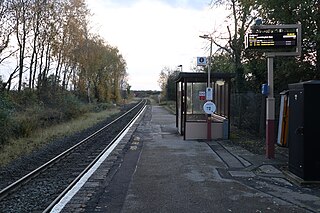
Bearley railway station serves the village of Bearley in South Warwickshire, England. It is on the Leamington–Stratford line. Today it is an unstaffed rural halt, managed by West Midlands Railway.
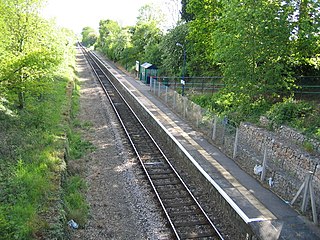
Claverdon railway station serves the village of Claverdon in Warwickshire, England. It is managed by West Midlands Railway, although most of the services from the station are operated by Chiltern Railways.

Wootton Wawen railway station serves the village of Wootton Wawen in Warwickshire, England. It is served by trains between Kidderminster and Stratford-upon-Avon via Birmingham.

The North Warwickshire Line is a suburban railway line in the West Midlands region of the United Kingdom. It runs from Birmingham to Stratford-upon-Avon, Warwickshire, now the southern terminus of the line, although until 1976 the line continued to Cheltenham as part of the Great Western Railway route from Birmingham to Bristol.
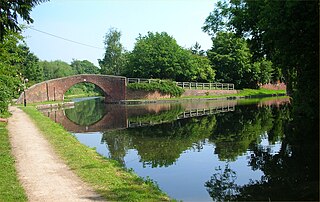
Kings Norton Junction is the name of the canal junction where the Stratford-upon-Avon Canal terminates and meets the Worcester and Birmingham Canal at Kings Norton, Birmingham, England.

Kingswood Junction is a canal junction where the Stratford-upon-Avon Canal meets the Grand Union Canal at Kingswood, Warwickshire, England.
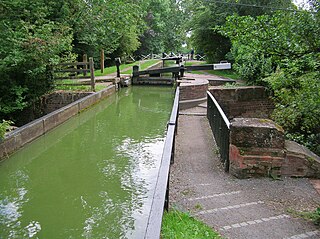
Yarningale Aqueduct is one of three aqueducts on a 4 miles (6 km) length of the Stratford-upon-Avon Canal in Warwickshire. It spans the Kingswood Brook near the village of Claverdon. All three aqueducts are unusual in that the towpaths are at the level of the canal bottom.
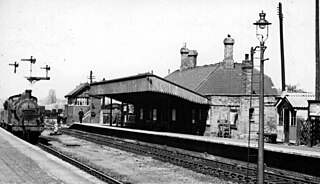
Stratford Old Town railway station was a railway station that served the town of Stratford-upon-Avon in Warwickshire, England. On the Stratford-upon-Avon and Midland Junction Railway, the station was built in 1873, adjacent to the Old Town district, south of the town centre.
Stratford-upon-Avon Racecourse Platform was a railway station on the Stratford upon Avon to Cheltenham section of the Honeybourne Line. Located one mile south of the town centre, its purpose was to serve Stratford Racecourse. It closed in 1968 as a result of falling passenger numbers.
The Alcester–Bearley branch line was a 6+3⁄4-mile single-track branch railway line in Warwickshire, England. It was built by the Alcester Railway Company. It connected the manufacturing town of Alcester into the Great Western Railway network, opening in 1876.

Wootton Wawen Aqueduct is one of three aqueducts on a 6 km length of the Stratford-upon-Avon Canal in Warwickshire. All are unusual in that the towpaths are at the level of the canal bottom.
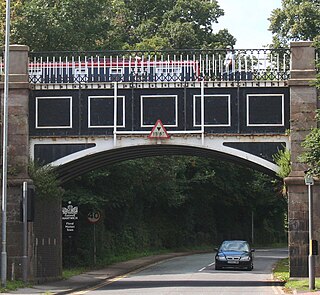
Nantwich Aqueduct is a navigable aqueduct in Acton in Cheshire, England, which carries the Shropshire Union Canal over the Chester to Nantwich road. Designed by Thomas Telford, it dates from around 1826 and is listed at grade II*.
The Stratford on Avon Railway was a branch railway line opened in 1860, to connect the town of Stratford-upon-Avon to the Great Western Railway main line at Hatton, in England. It was worked by the GWR. In 1861 it was connected through Stratford to a branch line from Honeybourne, and this later enabled the development of a through mineral traffic. The company was absorbed by the GWR in 1883.



















